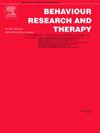The influence of (social) anxiety and visual exploration on threat responding and generalization
IF 4.5
2区 心理学
Q1 PSYCHOLOGY, CLINICAL
引用次数: 0
Abstract
Fear generalization has been identified as an important mechanism that might contribute to the etiology and maintenance of anxiety disorders. It is, however, yet unclear to what degree attentional processes contribute to overgeneralization of fear in clinical samples. To address this issue, we utilized a set of facial photographs that was meticulously created such that pairs of faces could either be distinguished by looking into the eyes or the region around mouth and nose, respectively. These pairs were then employed as CS+ and CS− in a differential fear conditioning paradigm followed by a generalization test with morphs in steps of 20 %, creating a continuum between CS+ and CS−. In a sample with diverse levels of social and general anxiety (N = 87), we demonstrated that the amount of fear generalization depends on attentional orienting towards diagnostic facial features. While social anxiety did not affect the shape of generalization gradients, we observed altered visual exploration patterns and a distinct multi-phasic heart rate modulation in participants with higher social anxiety. General anxiety symptomatology was also related to these characteristics of visual exploration and additionally predicted a broad elevation of threat ratings. In summary, fear generalization depends on attentional deployment. Future work should build on these findings to further explore these processes in clinical populations.
(社会)焦虑和视觉探索对威胁反应和概化的影响
恐惧泛化已被确定为可能有助于焦虑症的病因和维持的重要机制。然而,目前尚不清楚在临床样本中,注意力过程在多大程度上导致了恐惧的过度概括。为了解决这个问题,我们使用了一组精心制作的面部照片,这样就可以分别通过观察眼睛或嘴巴和鼻子周围的区域来区分成对的脸。然后将这些配对分别作为CS+和CS -在差异恐惧条件反射范式中进行,随后进行以20%的步骤进行的泛化测试,形成CS+和CS -之间的连续体。在一个具有不同水平的社交和一般焦虑的样本中(N = 87),我们证明了恐惧泛化的数量取决于对诊断性面部特征的注意力导向。虽然社交焦虑不影响泛化梯度的形状,但我们观察到视觉探索模式的改变和高社交焦虑参与者明显的多相心率调节。一般焦虑症状学也与这些视觉探索的特征有关,并且还预测了威胁等级的广泛提高。总之,恐惧泛化取决于注意力部署。未来的工作应该以这些发现为基础,在临床人群中进一步探索这些过程。
本文章由计算机程序翻译,如有差异,请以英文原文为准。
求助全文
约1分钟内获得全文
求助全文
来源期刊

Behaviour Research and Therapy
PSYCHOLOGY, CLINICAL-
CiteScore
7.50
自引率
7.30%
发文量
148
期刊介绍:
The major focus of Behaviour Research and Therapy is an experimental psychopathology approach to understanding emotional and behavioral disorders and their prevention and treatment, using cognitive, behavioral, and psychophysiological (including neural) methods and models. This includes laboratory-based experimental studies with healthy, at risk and subclinical individuals that inform clinical application as well as studies with clinically severe samples. The following types of submissions are encouraged: theoretical reviews of mechanisms that contribute to psychopathology and that offer new treatment targets; tests of novel, mechanistically focused psychological interventions, especially ones that include theory-driven or experimentally-derived predictors, moderators and mediators; and innovations in dissemination and implementation of evidence-based practices into clinical practice in psychology and associated fields, especially those that target underlying mechanisms or focus on novel approaches to treatment delivery. In addition to traditional psychological disorders, the scope of the journal includes behavioural medicine (e.g., chronic pain). The journal will not consider manuscripts dealing primarily with measurement, psychometric analyses, and personality assessment.
 求助内容:
求助内容: 应助结果提醒方式:
应助结果提醒方式:


